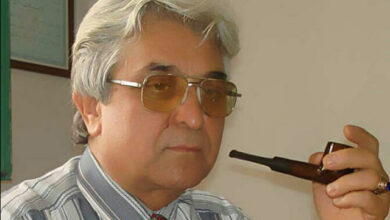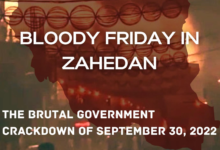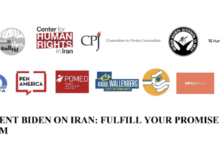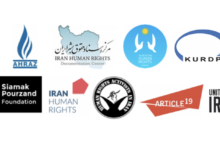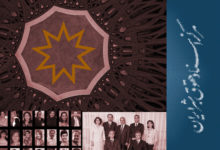Terrorist freed in Germany is welcomed by Tehran
Wednesday, December 12, 2007
There once was a well-known restaurant in central Berlin called Mykonos. Its Greek fare was said to be good, but it is now remembered for an altogether different reason: on the site of the former restaurant is a plaque — to which Iranian President Mahmud Ahmadinejad personally objected — that lists three Iranian-Kurdish leaders who were “murdered [here in 1992] by the then-rulers of Iran. They died fighting for freedom and human rights.”
The infamous “Mykonos Operation,” which shone an unprecedented light on the Islamic republic’s campaign to assassinate critics in the Iranian-exile community and sparked a diplomatic crisis between Europe and Iran, is back in the headlines. Some 15 years after Iranian agents killed three top members of the Democratic Party of Iranian Kurdistan (PDKI) and one of their supporters in a Berlin restaurant, Germany on December 10 released and deported two of the crime’s masterminds.
One of them, Kazem Darabi, was greeted by senior Foreign Ministry officials upon his return home. Leading the welcome at Tehran’s airport was Ali Baqeri, the acting head of the Foreign Ministry’s Europe section, in what some say amounted to an Iranian admission of complicity in a crime for which the regime has long denied responsibility.
While Baqeri himself denied any such conclusion, Shohreh Badei, a lawyer for the families of the Mykonos victims, begged to differ.
Speaking to RFE/RL’s Radio Farda, she criticized Germany for releasing Darabi and his Lebanese accomplice, Abbas Rhayel, in what German media are now speculating might be part of a planned prisoner swap between Israel and Lebanon’s Hizballah militia, which is backed by Iran. Rhayel, reportedly a Hizballah agent, was one of the convicted Mykonos gunmen and was deported this week to Lebanon.
“It was just a deal for the sake of political and economic gains,” Badei says. “Two terrorists, who have been so very loyal to the Iranian regime and their policies, have been released so easily, 10 years ahead of time. It has angered all Iranians.”
Mehdi Ebrahimzadeh was sitting at the same table in the Mykonos restaurant with the four men who were killed that day in September 1992. He realizes he is lucky to be alive.
“I saw a very tall person — taller than average — about 180-185 centimeters, whose face was covered up to his eyes,” he says. “Only his forehead was visible. He shouted some insulting words, probably to get our attention. Then I noticed some rays of light coming out of a handkerchief or cloth. Later I realized that the rays actually were bullets coming from his gun, which was wrapped in a sack.”
Ebrahimzadeh said he also disagrees with the decision by the German government to release the two men. “Personally…I don’t support vengeance,” he says. But “justice should be done, and justice should be restored in a democratic way.”
Iran’s Assassination Program Exposed
After a trial that lasted 3 and 1/2 years, a German court in 1997 concluded the Iranian government was “directly involved” in the killings. Chief Federal Prosecutor Kay Nehm issued an arrest warrant for Iran’s intelligence minister at the time, Ali Fallahian, and said Supreme Leader Ali Khamenei and then-President Ali Akbar Hashemi-Rafsanjani had knowledge of the crime. Other warrants were issued for two Tehran-based agents of the same ministry.
In reaction to the case, EU governments withdrew their ambassadors from Tehran and dropped their “constructive engagement” policy with the Islamic regime.
Darabi was identified as an agent of the ministry based in Germany. He recruited four Lebanese nationals, including Rhayel, to assist in the operation, whose primary target was PDKI leader Sadegh Sharafkandi, who had taken over the Iranian-Kurdish party after the killing in Austria of the previous PDKI head, Abdol-Rahman Ghassemlou.
According to court papers, the killers’ final preparations took place in the Berlin home of Darabi, who had “organized these killings for the Iranian secret intelligence. He was aware of the aim and had intentionally taken part in the murder of those four people.”
This plague commemorating the victims now stands at the site (AFP)To be sure, Iranian officials have been implicated in several other overseas terrorist acts, including the 1994 bombing of a Buenos Aires Jewish center that killed 85 people; the 1990 assassination of Kazem Rajavi, a professor, in Switzerland; and Ghassemlou’s killing in Vienna. But the Mykonos case is widely seen as being the most significant, according to the Iran Human Rights Documentation Center, an organization based in the United States.
That’s because the trial brought out operational details about Iran’s program to silence its exiled critics through a brutal program of overseas assassinations. The trial also included unprecedented testimony from a former high-ranking Iranian intelligence officer with direct experience in such operations. And the public release by German authorities of important intelligence exposed Iran’s program of assassinations in Western Europe.
For Darabi, though, all of that means little now.
In comments carried by the state-run IRNA news agency, Darabi said the decision to free him “proves I am innocent.” He denied any links to Iranian intelligence or any other organization: “I was only a member of the association of Muslim students in Europe. It was for this reason that I was arrested.”
He added that he intends to write a book in German. “I have spoken with a number of German authors who are going to come to Iran in the next months, and I will write about this scandal from the beginning to the end,” he said. “And with evidence, facts, and logic, I will prove to everyone that I was arrested without any evidence and that I am innocent.”
Nearly 10 years ago, a German court reached a different verdict. It’s still there for diners to see at the former site of the Mykonos restaurant in Berlin’s Wilmersdorf’s district: “They died fighting for freedom and human rights.”
(RFE/RL’s Radio Farda contributed to this report.)
Radio Free Europe / Radio Liberty © 2007 RFE/RL, Inc. All Rights Reserved.
http://www.rferl.org/content/article/1079258.html




